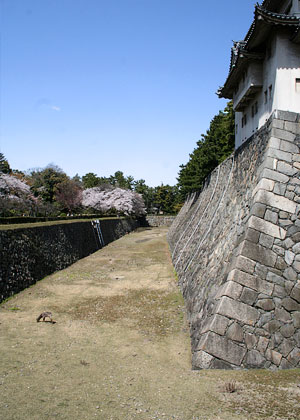|
||
 |
||

Nagoyajou 名古屋城 (Aichi)
(C)2001 Japanese Architecture and Art Net Users System. No reproduction or republication without written permission.
掲載のテキスト・写真・イラストなど、全てのコンテンツの無断複製・転載を禁じます。
|
||||||
| karabori 空堀 | ||||||
| KEY WORD : architecture / castles | ||||||
| A dry
moat, usually with a V-shaped cross-section called *yagenbori
薬研堀. The base of the moat was of earth or stone, so in battle enemy soldiers
falling into the moat were often killed or injured, whereas in a water-filled
moat *mizubori 水堀
they could swim to safety. Dry moats also gave castles a strategic advantage
because the enemy could not use boats to approach the walls. Karabori
are associated with medieval fortifications, and were large-scale structures.
Most mountain castles *yamajiro
山城, had dry moats, but flatland castles *hirajiro
平城, were usually located on low swampy ground so water-filled moats were
generally used. An exception is Nagoyajou 名古屋城 a flatland
castle built on a plateau: the main ward *honmaru
本丸 is surrounded by a dry moat. |
||||||
 Nagoyajou 名古屋城 (Aichi) |
||||||
| REFERENCES: | ||||||
| *shoujibori 障子堀 | ||||||
| EXTERNAL LINKS: | ||||||
| NOTES: | ||||||
(C)2001 Japanese Architecture and Art Net Users System. No reproduction or republication without written permission. 掲載のテキスト・写真・イラストなど、全てのコンテンツの無断複製・転載を禁じます。 |
||||||